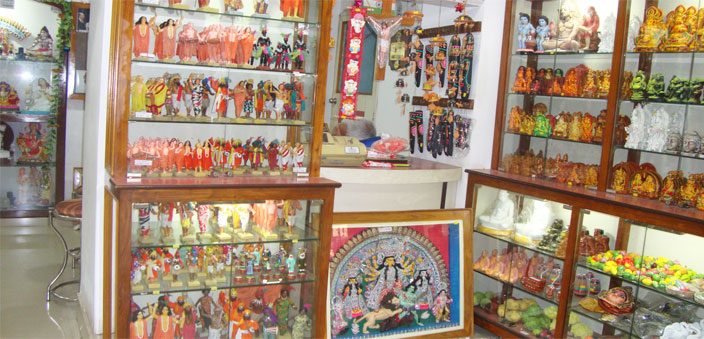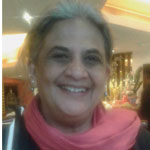Text photos: Manjira Majumdar
Krishnanagar, also spelt Krishnagore locally, is a small town, the capital of the district of Nadia, Bengal. The entire district witnessed an upsurge of the Vaishnavite movement in the 15th century in Bengal, due to Sri Chaitanya Mahaprabhu, who is revered among this sect of Krishna (considered an avatar of Lord Vishnu) devotees. Known largely for the sect’s preference for vegetarian fare, the people of the region swear by milk products. An array of delectable sweets, shorbajha and shorpuria, made with milk, chana (cottage cheese) and cream are the area’s unique specialities. During the reign of Maharaja Krishna Chandra Roy, (1710-83), art and crafts flourished, but today, the grand ruins remind us of his grander palace.
As the Krishnanagar local whistle stops at the busy station, the town bears the look of any congested small town of India. Phulia and Shantipur subdivisions within the district are better known for the Bengal cotton handloom sari-s. The ISKCON temple at Mayapur, dedicated to Radha Krishna, and where a sizeable number of foreign devotees in saffron robes, dance to the chants of Hare Rama Hare Krishna, is a 40-minute bus ride away.
A ‘miniature’ talent!
Krishnanagar has a few hidden talents, gradually vanishing with the passage of time. One of these is miniature modelling with clay by the community of potters or kumbhakara-s, to produce dolls and other figures. The potters as a community, are found all over the state, but in Krishnanagar, their artistry is collective as it is individualistic, and has been for generations. They are naturally gifted – the artistry passing from father to son and daughters too, except the latter, not unlike other artisans in Bengal, weavers included, help mostly in the miscellaneous work.
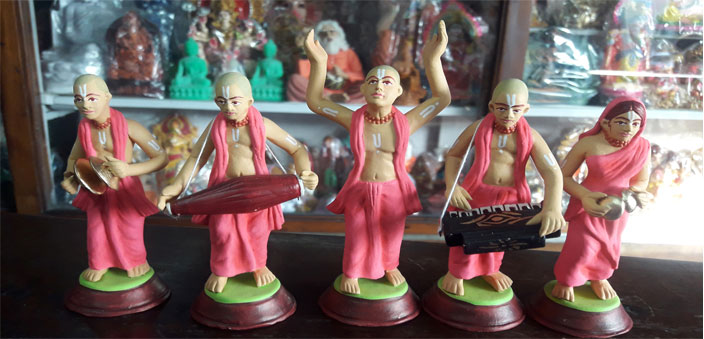
Exquisitely crafted, these mud dolls and figures in various sizes have delighted connoisseurs and layman alike, with their real life depictions of life around them. Figurines of gods and goddesses, Bengal rural scenes of thatched houses and palm trees, cobblers, priests, miniature eskimos, birds, animals, fruits, vegetables, etc., are replicated with precision and consummate artistry. The detailing of these figures, especially in their clothes and accessories are brought about by tools to create that single or double pleat, a crease here and there, and with a few strokes, life is infused into their eyes.
The tale of the putul
Putul is what a doll is known as in Bengal, and motorised cycle rickshaws gaily painted in reds, greens and yellows take me to Putulpatti, for a price. It is late afternoon, so several of the shops are shut. The larger area is known as Ghurni. The few shops that are open are manned by ladies. As one of them, Shikha Pal, married to Subodh Pal, says, “My husband models items which we sell through this shop.” The shelves are somewhat crammed with figurines of all shapes and sizes. Not all have the perfect finish. I learn that sculptors are a class apart, and most of the bulk work is done by craftspersons from the same community, but down the hierarchy. But for that perfect finish, it is the pair of hands of the mritshilpi (mrit = mud and shilpi = artiste).
Another elderly lady in the shop next door says her son has gone to fetch her grandchildren from school, so she is minding the shop for him. No longer are the craftsmen, stripped to the waist, sitting behind the potters’ wheel. Over the years, many have moved away seeking employment in figure making or in other areas. One or two storied houses have come up in a small lane, with about 20 odd shops, located on the ground floor. Those who can afford have hired workmen to meet orders for different statues, which are crafted in what they refer to as their private studios. The life-size figures are made on the outskirts, in a place called Bhatjangla on the National Highway. There are a few shops scattered around the town, taking orders or supplying pieces to the few shops in the city, which continue to stock them in small quantities. If there are any exports no one wants to divulge any details.
Blessed by the Pope
The stone tablet in front of the Pauls, the anglicised version of the surname Pal, is engraved with the name Sambhu Paul, 1976 ‘papal blessed’ sculptor. He had depicted a Bengal village scene which was blessed by Pope John Paul IV. One would have thought it was for a statue of Jesus Christ, of which there are several in his shop. Stocked are various images of Jesus Christ on the cross, or just busts and complete sets of nativity. The nativity sets move well during Christmas. They comprise the famous Bethlehem scene – the stable depicted by sheep, the three wise men bearing gifts, and of course, Baby Jesus in a crib. Every detail, down to the mud and straw are so well etched. The paint gives the wonderful effect of clothes, hair etc.
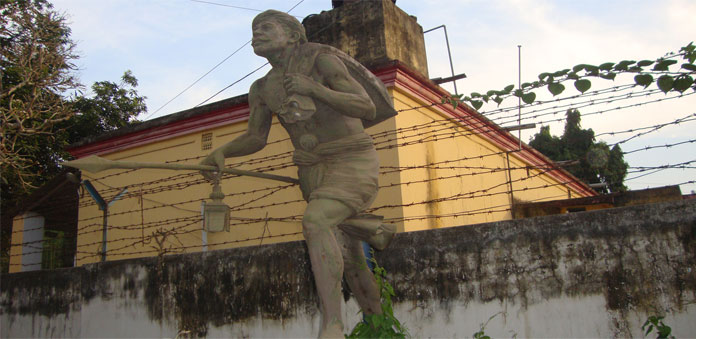
Pic courtsey : Rina Mukherji
Orders for figurines of Mother Mary, Jesus and Joseph used to be much more from the city, but now whatever orders come are from the churches in Bengal, for their grottos. Nadia is also known for its sizeable Bengali Christian population.
Images of Hindu gods and goddesses, especially the Radha Krishna pair, dominate, in addition to devotees in their light saffron garbs. However, goddess Durga, who is worshipped more as a community idol, are made by the same potter community, but are concentrated mostly in an area in north Kolkata called Kumartuli. The miniature Durga sets, 24 inches by 20 inches roughly, or even smaller, are time consuming, so they are made on the specific orders with individual potters. The prices vary according to workmanship.
Says Sashanka Paul, son of Sambhu, “Smaller craftsmen hired by many of us do the regular pieces or add the finishing touches, but for special order, the sculptors among us take over.” Other gifted sculptors of the region are Subir Pal, Kartick Pal, Norottom Pal, among many others who have been national awardees for their craftsmanship.
Clay and terracotta are the main medium of the general potters, and this is where their innate artistry takes over in crafting special images. The more popular stuff, in keeping with the times are small teddies, dogs in a basket, and valentine mementoes, which jostle for space on the shelves with a barber shaving his customer, a priest doing puja, or even a coal smith – the tiny coals set to perfection. Fridge magnates are another emerging item. Today, apart from clay, various other materials are used such as fibre glass, marble dust and spray paints in place of natural colours.
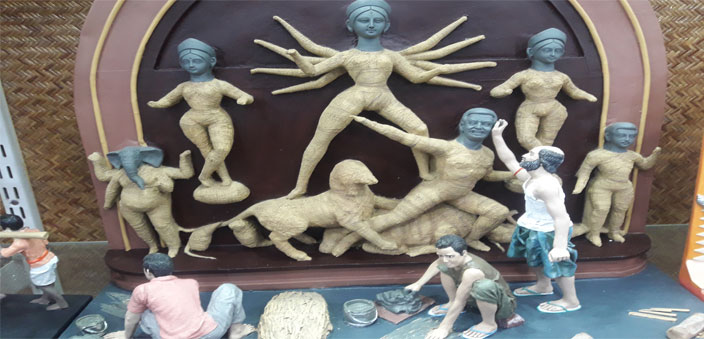
Whether it is the string of religious mendicants so well known in the area or sculptures of African women, the replication is perfect. However, newer modern figures have edged out those foreign figures, once copied from picture books perhaps. Modernity has crept in by popular demand, but these are, as mentioned earlier, in cute little figures; similar to fibre glass or PVC type materials. In fact, fibre glass is gradually becoming the preferred medium of these craftsmen/sculptors for convenience, and though the common consensus among potters is that they do miss the malleable nature of clay, the former is less cumbersome to stock, shift around or pack.
Community of potters and sculptors
The erstwhile zamindar-s of Bengal used to hire potters, naturally gifted with their fingers, to craft their idols for home puja-s, celebrated with due pop and gaiety. The potter usually took up residence within the zamindar’s household, where the perks included food and lodging. The concentration of Pal(s) in Krishnanagar is difficult to attribute to any particular source. Story has it that the local king Krishna Chandra Roy is reputed to have started Durga and Jagatdhatri (another avatar of Durga) puja in his fiefdom, and brought potters from Dhaka and Natore of North Bengal, 250-300 years back. They were skilled in miniature clay modelling too, which he patronised. During British rule, various busts in Greco-Roman style and native art were in great demand, because not only were mansions decorated with these figures, but were considered great gift items too.
Shashanka Paul does not like to exhibit his wares in fairs that the government has popularised for artisans to sell directly and without middlemen. Transporting these clay images is hugely risky and cumbersome,” he adds. “We take orders,” he adds, handing out his card.
The process
The potters take the mud from the banks of River Jalangi that flows through the town. To this clay is mixed water and kneaded almost like flour. To the mixture materials like cotton, rice husk, loam or sandy soil are added.
At least for the bigger pieces, the figures are shaped and mounted on a wire framework, which supports them and bent accordingly, to get the right fluidity. But for the detailing, it is those fine hands that make or unmake a piece of art. Various tools are used like basua – a blunt tip tool that creates the crests and folds in clothing and different knives to scrape and smoothen out the edges till a perfect figure emerges, ready to be painted. But not before they are dried either in the sun or in the kilns or furnaces.

The colouring of these clay dolls and images are not understated; on the contrary, extremely bright colours are used – green, blue, purple, orange, and yellow among other bright shades. Accessories or jewellery are painted for which pigments, dyes and poster colours are put to liberal use. There is a technique of polishing, earlier done with a natural material like tamarind seeds, but kerosene is also known to be used. All these processes, though encapsulated in a few written sentences, are extremely laborious and time consuming.
The threat to clay modelling
The threat to clay modelling has come from various quarters. The competition is most from other decorative objects that are today made with every possible material, adding to their versatility. Ceramic, terracotta, crystal, wood, stone, plastic, metal, resin; the list is indeed endless. Added to this are figurines coming from China as cheap replicas. But what matches and surpasses clay modelling today are figures made from marble dust. In likeness, it is difficult to tell them apart. “These are easier to maintain as they can be washed,” says a boutique owner inside an upmarket mall in Kolkata.
Beautiful and more detailed miniature Durga images complete with scenes of “sindoorkhela” among women, who smear each other when the Goddess is taken away for immersion on Vijayadashami. Some Durga images are on the boat or are depicted as being crafted. Other figures are the puchakawallah or seller of golgappas/panipuris. Priced between ` 2,000 and 4,000, these are competition for the poor clay potters, whose objects are more mundane, and may even cost as low as ` 50 for a pair of birds.
What the future holds
Naturally, young children do not play with clay dolls in India any more or decorate their homes during janmashtami or Christmas. Decorative items have lost their appeal as ethnic crafts, but those with a utilitarian value, are preferred today. The importance of such a craft has increasingly gone down, with families of potters having dispersed to other parts of India. As Sashanka Paul, explains, “Continuing is a huge challenge.” As his son returns from school, he is eager to show me some items; his father is not sure whether he should come into this profession of clay modelling. He says, “If he wants to move away fine, but if this is what he wants to do I have no objection. I would not also mind my daughter taking up clay modelling.” By a rough estimate, with about 300 odd traditional potters/sculptors remaining in and around Krishnanagar, it is a dying art, which needs to be revived with modern design inputs, infusion of capital and more exposure.
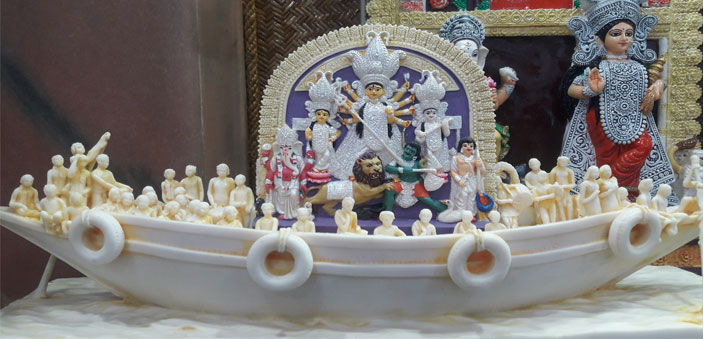
Sanjay Sarkar, who trained under Subir Pal, explains, “The absence of a packing industry in the area is also responsible for the art to slowly die.” The state government has tried to help on and off he tells me, but the time has come to move on in the absence of any huge development in this particular handicraft. Therefore, many such artistes are today crafting old and new images out of marble dust, fibre glass or some other materials to find new markets or simply to survive.

